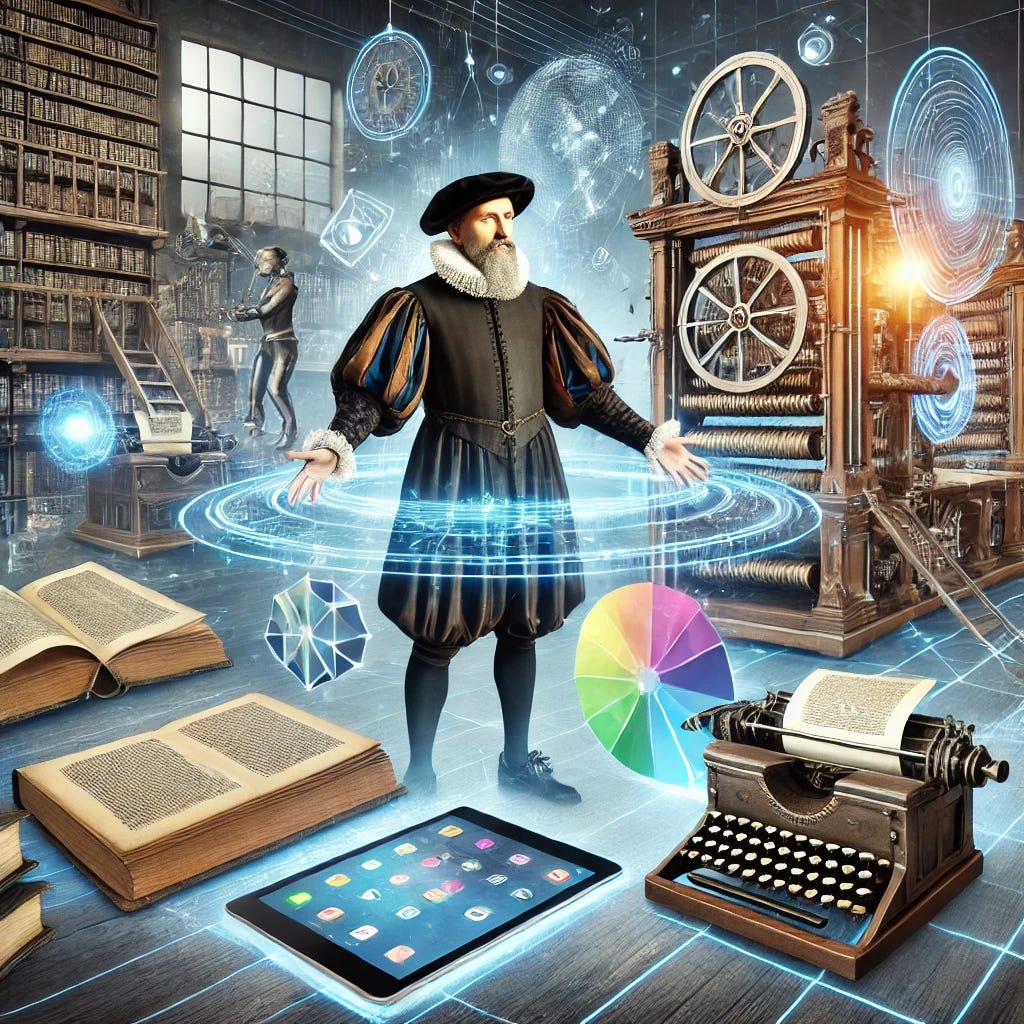Johannes Gutenberg in the Digital Age: Printing Press to Pixels
Past Forward: Historical Icons in the Digital Frontier #51
Voice-over provided by Amazon Polly
Also, check out Eleven Labs, which we use for all our fiction.
Preface
Johannes Gutenberg revolutionized the world with his invention of the movable-type printing press in the 15th century, a technological breakthrough that laid the foundation for the mass dissemination of knowledge. His press ignited the Renaissance, fueled the Reformation, and shaped the modern world by making books and ideas more accessible than ever before. But what if the father of print found himself in today’s digital age? How would he react to a world where publishing has gone from ink on paper to pixels on screens? Would he embrace the democratization of information or recoil at the consequences of unlimited, unchecked communication? As we reimagine Gutenberg navigating the complexities of digital publishing, social media, and the internet’s influence on knowledge, we explore how his legacy continues to shape—and be challenged by—modern technology.
Arrival in the Digital Age
Johannes Gutenberg wakes to a strange new world, a place where books glow from glass screens, where words can be summoned at the tap of a finger, and where presses have been replaced by digital platforms. His first instinct is to seek out a printing house, only to find that most are now small, digital operations. He stumbles into a modern bookstore, where shelves are lined with beautifully bound books—yet he notices fewer people browsing. Instead, they are glued to handheld devices, swiping through what appear to be books and articles displayed in moving light.
As he moves closer, he overhears a conversation between two young readers debating the merits of digital versus physical books. One praises the convenience of carrying an entire library on a single device, while the other laments the loss of the tactile experience of turning pages. Gutenberg listens intently, realizing that reading itself has not disappeared, only transformed.
Curious, he inquires about these “e-books” and “audiobooks,” marveling at the convenience they provide. No longer is printing an arduous process requiring meticulous typesetting and laborious manual presswork. Instead, anyone with a computer can publish a book instantly. He is both awed and uneasy. Has the craft of printing been lost, or has it simply evolved beyond recognition?
Seeking deeper understanding, he visits a public library—only to find it vastly different from the scholarly institutions of his time. Instead of rows of scribes copying texts, he sees people working on computers, accessing archives of books and periodicals with a few keystrokes. A librarian, noticing his fascination, explains that modern libraries serve as information hubs, providing not just books but digital access, research assistance, and educational programs. She introduces him to the internet, a boundless network where all written knowledge can be accessed instantaneously.
She guides him to Wikipedia, Project Gutenberg, and Google Books, where entire libraries are digitized and freely available. At first, he rejoices—the free circulation of information is the very dream he had when he first constructed his press. But as he scrolls through social media and news sites, he is confronted with the darker side of this accessibility: misinformation, propaganda, and the dilution of truth. He watches as people argue over false reports, sees clickbait headlines drawing attention away from meaningful discourse, and realizes that while information is now free, wisdom remains as elusive as ever.
The Printing Press and the Internet: A Parallel Revolution
Gutenberg quickly realizes that the internet is to the modern world what his printing press was to the 15th century. Just as his press shattered the monopoly of scribes and empowered people to read and think for themselves, the internet has done the same—on a much larger scale. His invention once threatened the Church’s control over religious texts, much as the internet now threatens traditional gatekeepers of knowledge: newspapers, governments, and academic institutions.
However, he is alarmed by the speed and reach of modern publishing. In his day, the printed word had weight—each page laboriously set, inked, and pressed. Now, anyone can publish an idea without scrutiny. With no master printers or editors to verify facts, he wonders: has the ability to publish without restraint led to a degradation of truth?
As he explores further, he encounters online forums and comment sections brimming with unfiltered opinions, some insightful, others baseless. He watches as misinformation spreads faster than corrections, much like the religious and political tracts of his own time, which often contained exaggerations or outright fabrications. But unlike in his era, where the cost of printing imposed a barrier, making mass publication a privilege of a few, the internet has removed nearly all limitations. Now, a single individual can reach millions instantly, for better or worse.
He recalls the early days of printing, when pamphlets and broadsheets spread revolutionary ideas across Europe. Some were noble, others were incendiary. He sees a mirror in today’s social media, where ideas spread like wildfire, unfiltered and unchecked. He is particularly disturbed by clickbait, deepfakes, and AI-generated misinformation—tools that manipulate truth rather than preserve it. Would his invention, had it been capable of such mass proliferation, have faced similar issues?
Seeking balance, he investigates modern journalism and the role of fact-checkers. He learns about institutions dedicated to verifying claims, much like the scholarly guilds of his time ensured quality manuscript copying. He appreciates efforts to uphold integrity in reporting but is troubled by the growing distrust in traditional media, much like how the Church once resisted printed texts that challenged its authority. Gutenberg wonders: is this the cost of an open marketplace of ideas, where truth and falsehood compete on equal footing?
Social Media and the Dark Side of Information Democracy
As he explores social media platforms like Twitter (X), Facebook, and TikTok, Gutenberg is astonished at the volume of information exchanged every second. What once took months to distribute via books and pamphlets now spreads globally in an instant. Yet he also observes the chaotic nature of this ecosystem: scholars and fools alike have equal platforms, sensationalism overshadows thoughtful discourse, and echo chambers distort reality.
As he watches a heated online argument unfold in real-time, he is stunned by the sheer intensity of opinion-driven content. Rational discourse, which he once believed would flourish under the freedom of information, is often drowned out by reactionary statements, personal attacks, and emotionally charged rhetoric. He notes that while his printing press had once fueled intellectual debates, the speed of social media has turned discussion into a rapid-fire exchange where depth and nuance are often sacrificed for immediate engagement.
He listens to debates on censorship and free speech, noting that while his printing press empowered reformers like Martin Luther, it also allowed for the unchecked spread of radicalism and falsehoods. The parallels between the Reformation’s pamphlet wars and today’s social media conflicts are uncanny. Information has never been so free, yet never so volatile.
Gutenberg considers whether his press, if it had been invented today, would have been celebrated or feared. Would society have embraced it as a tool for enlightenment, or would it have been seen as a threat, much like how governments and corporations struggle with regulating digital platforms today? He ponders whether the promise of free expression has been overshadowed by the weaponization of information, as voices once silenced by traditional institutions now flood the digital space, not always in the pursuit of knowledge, but often for influence, manipulation, or profit.
As he navigates different social media spaces, he is particularly struck by the algorithms that curate content for users. He realizes that these invisible forces shape what people see, creating digital echo chambers where individuals are constantly reinforced in their existing beliefs. Instead of broadening perspectives, these platforms can entrench biases, leading Gutenberg to wonder whether his dream of an informed, literate society has been compromised by the very tools meant to achieve it.
Collaboration with Modern Publishers and Technologists
Determined to understand how publishing has evolved, Gutenberg meets with digital publishers, journalists, and authors. He is fascinated by self-publishing platforms like Kindle Direct Publishing, which allow authors to reach global audiences without intermediaries. Yet he is also troubled by the flood of content—how can readers discern quality amid the noise?
To gain deeper insights, he visits editorial teams at major online publications and observes how digital journalism has adapted to the rapid-fire nature of internet discourse. He learns about paywalls, subscription models, and ad-driven revenue streams, concepts foreign to the 15th-century printing economy. While he admires the ability of these platforms to instantly distribute news, he is uneasy about the reliance on engagement metrics that prioritize sensationalism over substance. He wonders whether this is the cost of an information economy where attention itself is the most valuable currency.
He collaborates with scholars on a project to restore the balance between accessibility and credibility, advocating for digital tools that verify sources and highlight trustworthy publications. He suggests the creation of a modern equivalent to the early printer’s colophon—a digital mark of authenticity that indicates a work has been fact-checked and curated by trusted authorities. Inspired by modern typography and design, he explores AI-driven typesetting and automated book production, marveling at how these advancements refine his original vision. He experiments with adaptive publishing tools that tailor formatting to readers’ preferences, from audiobooks to immersive multimedia experiences.
Gutenberg also experiments with blockchain technology, which offers a way to authenticate and preserve original texts. He recognizes its potential to combat plagiarism, counterfeit editions, and misinformation, much like the distinctive marks of early printers ensured authenticity in his time. He envisions a system where historical and scholarly texts are encoded with a digital ledger that ensures their integrity, preventing them from being altered or misrepresented. He notes with satisfaction that while the physical printing press is no longer the dominant force in publishing, its principles—preservation, verification, and the spread of knowledge—remain vital in the digital age.
Legacy and Modern Influence
As his journey through the digital world comes to a close, Gutenberg reflects on his enduring legacy. He sees that the spirit of his invention—spreading knowledge far and wide—lives on in digital publishing. Yet he also sees that technology alone cannot ensure truth, wisdom, or understanding. Just as the printing press needed responsible printers, the internet needs responsible curators.
He leaves behind a message to modern publishers, educators, and readers: technology may change, but the pursuit of truth remains eternal. Whether printed on a page or displayed on a screen, words carry power. It is up to humanity to use that power wisely.
Gutenberg vanishes into history once more, leaving the digital world to continue his work—refining, preserving, and democratizing knowledge for generations to come.
Thank you for your time today. Until next time, stay gruntled.
Do you like what you read but aren’t yet ready or able to get a paid subscription? Then consider a one-time tip at:
https://www.venmo.com/u/TheCogitatingCeviche
Ko-fi.com/thecogitatingceviche







